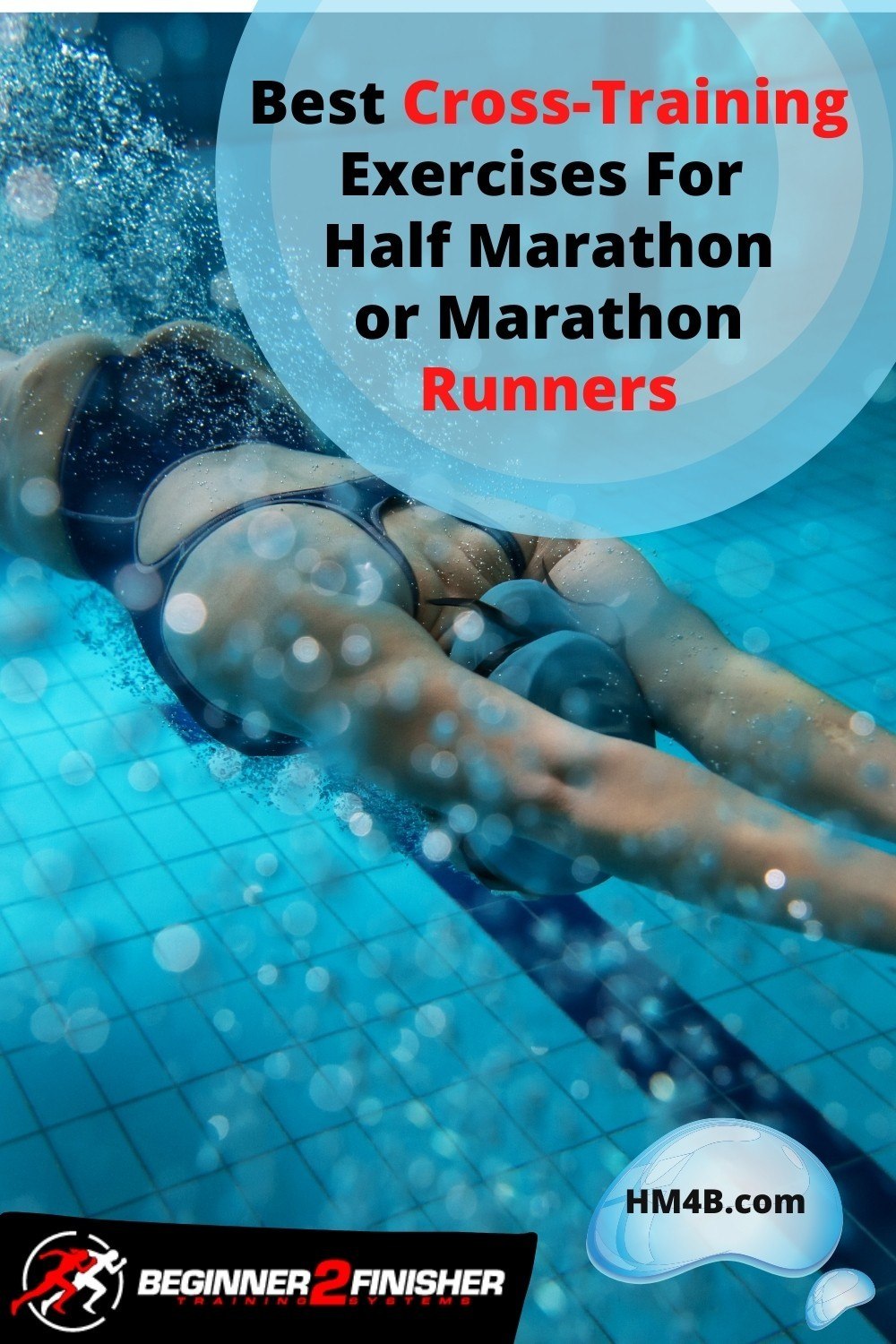When training for a marathon you would expect running more to be the best way of training. Although this is true for the most part, incorporating other types of exercise might be even better for getting fit. Targeting different parts of the body and using different methods can really help.
But what is the best cross-training exercises for half marathon/marathon runners?
Low impact exercises are a great way to compliment and even make your running training more effective. By taking the load off of your legs and/or joints, exercises like swimming or cycling that include no impact, you can improve your cardio with fewer injuries.
When your legs are aching and your joints are feeling the effect of weeks of training, cross-training with other exercises can also be a real help in strengthening those imbalances that cause injuries.
The first thing to consider when thinking about cross-training exercises is what and how they will benefit your running. To be good at running you need a balanced chain of muscles and joints that can withstand impact and last a few hours of constant running.
As running is a unilateral movement—meaning your legs only move on one axis—you can easily lose strength in areas that control your legs moving in other directions. These imbalances can add up and cause injury down the line. Let’s look at how to avoid them.
Let’s look at some great examples of cross-training exercises to help you train for that marathon or half marathon.
Best Overall Cross-Training Exercise For Long-Distance Runners
Cycling
Riding a bike is a great way to exercise. For runners, the best bang for your buck when riding a bike can be found in high-intensity interval training. Spin classes or guided programs will have you sweating like never before. You’ll be far fitter in no time.
Because cycling uses slightly different muscles to running, combining the two will mean you have stronger legs all around. Cycling is also a low-impact exercise that means your ankles, knees, and hips take far less strain for every movement.
Interval training on a bike is ideally incorporated once or twice a week. Sessions normally last between 30 and 45 minutes which include periods of easy cycling before periods of all-out sprinting. The intense periods are well the real gains are made.
Pushing your muscles to the max then letting them recover briefly before launching into another sprint will make your muscles far more efficient at draining lactic acid. Lactic acid builds up when you use your muscles—it’s what makes them hurt when you’re going hard.
Having better lactic acid regulation means your muscles will not hurt as quickly and you can go harder for longer. In fact, some people are genetically predisposed to be better at regulating lactic acid than others. Even so, everyone can improve their lactic acid regulation.
Best Cross-Training Exercise For Long-Distance Runners If You’re Strapped For Time
For those runners who have limited time on their hands, there is one form of cross-training that will really help you out.
Weight Lifting
That’s right, those huge bodybuilders are doing something right. Weight lifting will strengthen your entire body which will see you become far less prone to injury, and far more economical when you run. Some muscles just do not get trained during running but are essential.
Doing what’s known as compound lifts—that’s the bigger lifts that incorporate multiple body parts, like squats, bench press, and deadlifts—you can strengthen your entire body and make it far more sturdy and efficient. Even light weights will help you hold a better posture.
A weight lifting session can take less than an hour if you are short on time. Simply get in the gym, warm-up, and start lifting. Doing just a few sets of the compound lifts is enough. If time is short, you should really look at weight lifting.
If gyms are closed for the pandemic, and you do not have access to weights, you can even do bodyweight exercises to strengthen your body. Bodyweight squats, planks, push-ups, and leg raises can all help you massively.
What Are Some Other Good Cross-Training Exercises for Runners?
Swimming
Swimming is a great form of exercise in its own right. Unlike running, swimming incorporates more upper body strength in order to move through the water. Stress is taken off of the joints that take impact during running and your whole body is exercised.
This can benefit your running by strengthening your core muscles (10 Great Core Exercises For Runners) so your body holds itself in better posture as you run. Likewise, your cardiovascular system will benefit from swimming. Like running swimming will get your heartbeat up and will have you out of breath.
Rather than destroying your toes and worsening those blisters, why not take a dip in the pool and swim some lengths. Another good thing about swimming is how relaxing it can be. Your body is supported by the water and you can very easily slow down if need be.
Swimming in freshwater is also a good way to build mental strength. There are many freshwater swimming locations that allow you to take a dip as if you were in the wild. Forcing yourself into the cold water will make you mentally strong and ready to tackle the marathon/half marathon.
Aqua Jogging
Have you heard of aqua jogging? This is a great exercise for individuals that need a little less impact on the joints. Since this lessens the impact on your running muscles you can use aqua jogging as a cross-training exercise as long as you only train at an easy to medium effort. Check out my detailed post on what aqua jogging is and how to get started with simple routines.
Walking
Walking may not seem like a great way to improve running, as it is considered a more mundane form of exercise. However, walking long distances over long timespans is a great way to build up the endurance and mental fortitude that is needed for an entire marathon or even half marathon.
Walking can even be incorporated into your running. Some athletes even train with walking intervals added into their runs. Why not try running for 9 minutes and walking for 1. You will find you can run so much further with those little breaks. More miles means more benefit.
If you try the run/walk method you may even be surprised to see your running times stay the same. Even though you are not running the entire time, the energy you regain from the breaks factors into when you are running again. This is also a great way to avoid falling into bad posture.
For a detailed dive into the run/walk method of running, check out this post:
How to use the Run/Walk Method – A Complete Guide
Of course, walking alone can also be a great way to cross-train, particularly hiking. Walking up hills and across the uneven ground can strengthen the muscles that stabilize each step. With stronger stabilizing muscles you are far less prone to injury.
Another benefit of walking is the mental gains. Walking for hours on end, keeping a good pace, and being alone with your thoughts is a great way to build a mental fortitude that can cross over into running. Running is very hard mentally so walking can train you for those long hours.
Walking is also a great social hobby, many people enjoy hiking. Why not make a day of it and go hike in the wild with some friends? You can even practice what nutrition works best for you. Take some snacks and experiment to see what suits your energy needs over a long day.
How Often Should I Be Cross-Training For A Marathon?
Because running can take such a toll on your feet, muscles, and joints, cross-training is a great way to still get the cardiovascular workout without the same detrimental effects.
Ideally, you will incorporate cross-training into your program once or twice a week. For example, most marathon training plans include a long run on Sundays. If this is the case, you will be aching more on Monday and Tuesday. Cross-training on these days will ease you into the week.
As well as taking the strain off your body, cross-training after a big weekend of running is a good way to keep things fresh. Running day after day with no variation is a quick route to burning out and getting bored of your routine.
Mix up your routine by throwing in some cross-training and you will be eager for the next few days of running. A training routine trains the mind as well as the body. Keeping things interesting will make things feel a lot easier.
The Takeaway
Overall, training for a marathon or half marathon is a difficult thing. Anything to make it easier should be embraced. By incorporating cross-training into your program, you can help yourself in many different ways.
Your body will be more economical for running, your mind will be relieved from the constant running, and you will be far less prone to injury. As running is a very one-dimensional sport, involving other sports that use other parts of the body will make you more dynamic.
Remember that at the end of the day, running is the goal. If you find that cross-training is detracting from your running gains, then by all means leave it out. Cross-training should be supplemental rather than compulsory. Just make sure you’re enjoying your training.
New To Running?
Are you wondering how to get started as a new runner, check out this New Runner FAQ I put together that includes posts such as:
- How Long Does It Take To Become A Runner?
- How Long Does It Take To Walk One Mile?
- How Long Does It Take To Walk A Marathon?
- Why Is Running So Hard?
References
https://www.active.com/cycling/articles/the-best-cross-training-for-runners
https://www.runnersworld.com/training/a20827090/16-cross-training-activities-to-try/
https://www.outsideonline.com/2402061/cross-training-runners
| Help support me and subscribe to my YouTube channel. YouTube video - 30 ways to make your runs less painful! Coach Scott's Credentials:
|
To sign up for a FREE half marathon training schedule, log sheet, and pace predictor CLICK HERE.

Recommended gear for runners
Connect with me:
| facebook.com/BeginnerToFinisher/ |


3 thoughts on “Best Cross-Training Exercises For Half Marathon or Marathon Runners”